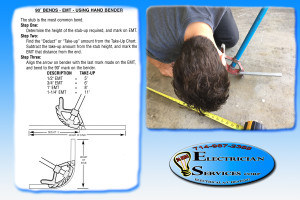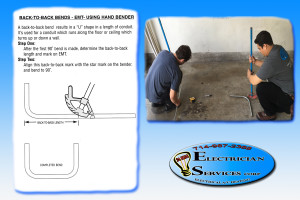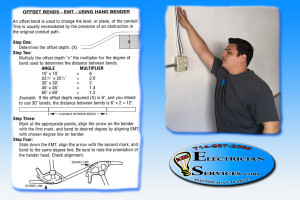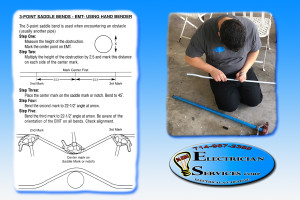Conduit Bending Orange County
Bending electrical conduit, or EMT, is a task that a Orange County Electrician will face sometime in their careers, particularly if they are working in the commercial or industrial fields. It can be quite overwhelming for the new apprentice, and even for the experienced journeyman, if they are asked to bend the conduit to a particular shape they are not familiar with. The charts below illustrate how to construct certain bends using a conduit bender. There are different benders for different size conduit, by following the charts below and some measuring you can learn how to construct the 4 basic bends in the electrical field.
90 Degree Bend
The 90 degree bend is the easiest to construct with a bender. The “stub-up” bend is the most common. First step is to determine how high the stub-up bend is needed. Once this is determined measure and mark the conduit. Then Subtract the “take-up amount found on the take-up chart. Every conduit size is different make sure that you deduct the correct amount with the correct bender. On a flat level plain, simply place the bender on the conduit and line up the arrow on the sound mark or the take-up that was deducted from the full measurement. Then simply bend the conduit up until 90 degrees is constructed on the conduit.
Back-To-Back 90 Degree Bend
The Back-to-Back is another common bend in the electrical field. A back-to-back bend can look like a “U” shape or even an “S” shape. Depending on the application the steps are the same, simply on a flat level plain construct the first 90 degree bend and then measure from the back of the 90 degree bend to the area where the conduit will construct up or down the wall. Simply measure and mark this on the conduit from the back of the 90 degree from the first bend. Then construct the other 90 degree bend up or down to create a “U” shape or “S” shape depending on the application needed.
Off-Set Bend
The off-set bend is another common bend in the electrical field, The off-set bend is normally used for the “box off-set”, this is where the conduit enters the box. Another off-set bend that is constructed, is by bending conduit over obstructions like duct work for air conditioning in Orange County or ( conduit, pipes, etc.) Off-sets can also be constructed for a 4-point saddle bend which is simply a back-to-back off-set. Once the electrician has mastered the off-set bend the 4-point saddle will come naturally to the electrician.
3-Point Saddle Bend
The 3-point saddle is constructed to avoid other obstructions like the 4-point saddle. The 3-point saddle is not like the 4-point saddle that is construct with 2 offset bends. The 3-point is constructed by 3 points on the conduit. Simply measure from the first point of the conduit “run” or path and measure to the center point of the obstruction and mark this on the conduit. Then measure the height of the obstruction and multiply 2.5 to the height of the obstruction and mark the calculation from the center mark on the conduit from each end from the center mark on the conduit. Then simply on a flat level plain, bend the middle mark to a 45 degree bend. After the first bend simply flip the conduit over and bend 22 1/2 degrees on the last 2 marks on the conduit.




